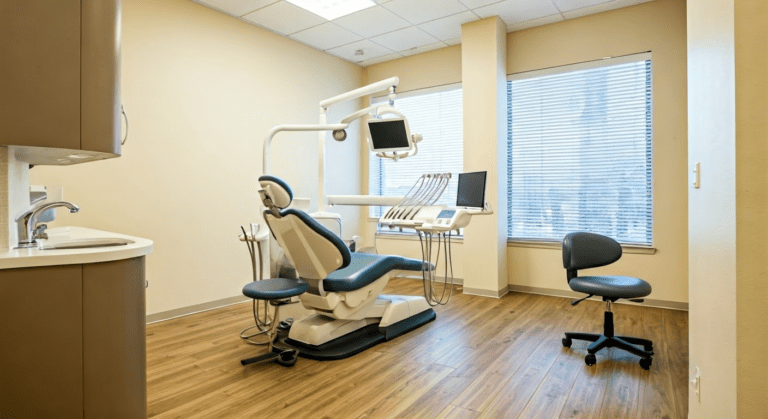How to Implement Block Scheduling Dental Office Effectively?
What Is Block Scheduling in Dental Offices?
 Imagine this: You're in your dental office, and your day is a mix of quick cleanings, longer root canals, and consultations. Without a clear structure, you run behind, deal with last-minute rescheduling, and feel overwhelmed.
Now, picture dividing your day into specific time blocks for each type of procedure—cleanings in one block, fillings in another, and consultations at set times. This is block scheduling.
Block scheduling divides the workday into set time slots for specific procedures, reducing interruptions and optimizing workflow. This method improves patient flow, minimizes wait times, and boosts productivity, making your day more efficient and less stressful.
Imagine this: You're in your dental office, and your day is a mix of quick cleanings, longer root canals, and consultations. Without a clear structure, you run behind, deal with last-minute rescheduling, and feel overwhelmed.
Now, picture dividing your day into specific time blocks for each type of procedure—cleanings in one block, fillings in another, and consultations at set times. This is block scheduling.
Block scheduling divides the workday into set time slots for specific procedures, reducing interruptions and optimizing workflow. This method improves patient flow, minimizes wait times, and boosts productivity, making your day more efficient and less stressful.
What Are the Potential Benefits and Drawbacks of Block Scheduling?
Block scheduling can streamline your practice, but it needs the right approach. Here's how it can benefit you — and what to watch out for.Benefits of Block Scheduling:
- Better Organization: Imagine a dental office where every room is scheduled for specific procedures—cleanings in one, exams in another. This structure prevents confusion and keeps things running smoothly, which is essential for dental office managers. Without it, you might end up double-booking or scrambling for space.
- Enhanced Productivity: If your team has a block of time dedicated solely to routine cleanings, they can focus, avoid distractions, and complete them faster. Without this focus, staff might jump from task to task, leading to inefficiencies.
- Improved Patient Experience: With block scheduling, patients spend less time waiting and more time with the dentist. They appreciate the attention and efficiency. Without this, wait times could balloon, frustrating patients and damaging your reputation.
Drawbacks of Block Scheduling:
- Requires Substantial Planning: Train your team and closely monitor the schedule to make block scheduling work. If you don't, you might face delays or miscommunications. For instance, staff may forget to account for setup time between procedures.
- Lacks Flexibility: What happens when an emergency case walks in? A rigid schedule could cause delays or force you to rush other appointments without flexibility. It's crucial to have buffer time to handle unexpected situations.
How to Create an Effective Block Scheduling Framework?
 Creating a practical block scheduling framework is key to streamlining your practice and enhancing patient care. It's not just about filling time slots—it's about strategically organizing your day to maximize efficiency. Let's explore how you can build a system that works for both your team and your patients.
Creating a practical block scheduling framework is key to streamlining your practice and enhancing patient care. It's not just about filling time slots—it's about strategically organizing your day to maximize efficiency. Let's explore how you can build a system that works for both your team and your patients.
1. Identifying Key Procedures
To create a genuinely effective block scheduling system, focus on the procedures that directly impact your practice's bottom line. For example, if crown placements are more profitable than routine exams, prioritize them during high-energy hours. You may face the pain point of misallocated time—like scheduling routine cleanings for long blocks, only to realize they don't bring in much revenue. Categorize your treatments into high, medium, and low ROI to avoid these mismatches and streamline your day.2. Allocating Time Blocks
Once you've identified your key procedures, the next challenge is allocating the right amount of time. If you consistently feel rushed or overbooked with complex treatments like implants, it's time to adjust. For example, schedule implant procedures during your team's peak performance time, like early morning, when everyone's fresh. Conversely, simple fillings or check-ups can be slotted for later when the team's energy may dip. Without this careful balance, you risk burnout, rushed procedures, and poor patient experiences.3. Managing and Optimizing Block Scheduling
Managing block scheduling isn't a one-time effort; it's a constant process. If you're finding that appointments often run longer than planned—like crowns taking more time than expected—you're not alone. Address this by giving those treatments more time or adjusting the schedule to allow flexibility. Pay attention to cancellations and no-shows, too—these gaps can throw off the entire day if not handled quickly. Keep your team involved in these evaluations during your morning huddle; they're the ones who experience the real-time struggles and can offer crucial feedback. Without constant fine-tuning, you'll face the pain point of inefficiency, where the schedule becomes more of a burden than a tool.What Are Some Tips for Successfully Implementing Block Scheduling?
Implementing block scheduling requires more than just a plan—it involves communication, training, the right technology, and flexible patient scheduling policies. Here's how to make it work effectively.1. Ensuring Staff Communication and Training
To make block scheduling successful, clear communication and training are key:- Imagine your receptionist is struggling with new scheduling software. Provide hands-on training and set up quick reference guides to ensure they feel confident in their role.
- What if your dental hygienist is frustrated with sudden changes in the schedule? Hold regular team check-ins to address concerns and provide feedback, ensuring they feel heard and supported.
- Suppose your dental assistants are unclear on scheduling priorities. Build an open forum where staff can voice their thoughts or concerns about the issues they face so together, you can find the right solution.
2. Leveraging Dental Software for Patient Management
Using the right software can simplify your practice's workflow:- Imagine a patient calling for an appointment, but the schedule is already packed. With the right dental software or a patient portal, you can instantly see available slots and offer the patient an appointment, reducing the risk of losing that patient.
- What if your team forgets to send appointment reminders? The software's automation features can handle reminders for you, ensuring fewer no-shows and smoother daily operations.
- Suppose your practice is overloaded with data from different sources. Dental software consolidates everything in one place—patient history, scheduling, and billing—so you can focus on care, not paperwork.
3. Creating a Patient Scheduling Policy
A well-designed scheduling policy keeps things running smoothly:- Imagine a patient calling for an appointment but wanting to book far in advance. Your policy could encourage booking within a specific window by offering the next two available times, helping you fill slots efficiently and avoid gaps.
- What if there's a last-minute cancellation? Create a policy prioritizing rescheduling or filling open slots quickly, ensuring minimal downtime and maximizing your schedule.
- Suppose you have a procedure that needs to be prioritized. Set clear guidelines for handling urgent cases, so patients are seen promptly without disrupting the flow for others.
How to Address Challenges and Common Mistakes?
Implementing block scheduling in dental offices may have challenges despite its many benefits. Potential pitfalls include staff resistance, overbooking or underbooking, and difficulty adjusting patient schedules to align with the block schedule framework. Let's understand how they can affect the workflow.1. Dealing with Staff Resistance
Change is hard, but it doesn't have to be a battle. When the team understands the "why" behind the shift, they'll be more likely to accept it. Trust and communication are the keys to success here.- Be transparent and explain to them how block scheduling benefits the office and everyone involved.
- Offer support and training during the rollout.
- Encourage feedback to improve the process.
2. Managing Overbooking or Underbooking
Overbooking and underbooking are more than scheduling issues—they affect the flow of your entire day. You can avoid these common headaches and keep everything running smoothly by staying proactive.- Look at past data to understand booking trends.
- Keep an eye on the schedule and adjust as needed, especially when you notice a canceled appointment.
- Use dental software to predict and optimize your bookings.
3. Ensuring Patient Adjustments
Patients want convenience, and the transition to block scheduling doesn't have to be a hassle. Clear communication and flexibility are essential to keeping them satisfied and loyal.- Clearly explain new appointment windows.
- Reassure them that care quality stays top-notch.
- Stay flexible, especially when emergencies pop up.
Block Scheduling in Action: Dental Block Scheduling Template for Reference
As mentioned earlier, Block scheduling can significantly improve your practice's efficiency, reduce stress, and boost productivity. To help you get started, here's a template you can replicate. However, customizing this to fit your practice's needs will ensure a smooth transition and better results.Sample Day with Block Scheduling
| Time Slot | Procedures Scheduled | Focus/Benefits |
|---|---|---|
| 8:00 AM - 12:00 PM | Complex procedures (crowns, implants) | Focus on high-value, time-consuming work with fewer distractions |
| 1:00 PM - 3:00 PM | Moderate procedures (fillings, extractions) | Efficient use of time for mid-level procedures |
| 3:00 PM - 5:00 PM | Routine check-ups & cleanings | Quick, streamlined visits to wrap up the day |




